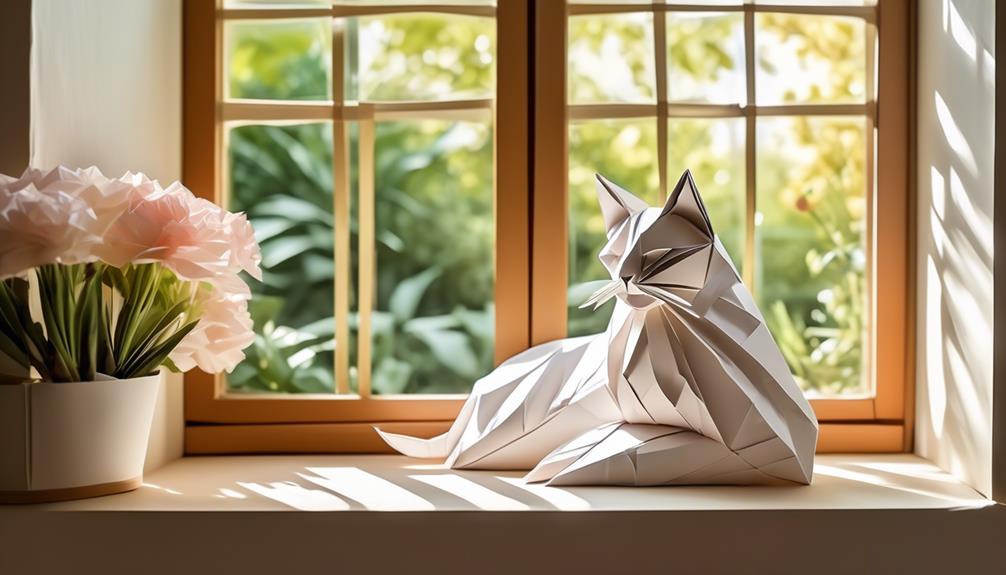As your cat gets older, they may become less active due to joint pain, making daily activities harder for them. It’s important to modify their routine to include gentle exercises that are easy on their joints.
From the way you carefully craft their environment to the softness in your voice when you call them for dinner, every action speaks of the love and care you hold for them. To help them thrive, consider introducing gentle exercises tailored for their delicate condition, which can strengthen their muscles, increase flexibility, and improve overall well-being without exacerbating any discomfort.
Stay tuned as we explore six of the most nurturing workouts that will bring a newfound ease to your aging cat’s life, ensuring their days are filled with the same joy and comfort they’ve brought to yours.
Key Takeaways
- Consult with a veterinarian before starting an exercise routine for an aging cat with joint pain
- Low-impact play sessions using interactive toys and puzzle feeders can keep cats moving without stressing their joints
- Gentle stretching exercises can enhance flexibility and alleviate stiffness in aging cats with joint pain
- Controlled leash walks on flat and even terrain, using a snug and supportive harness, can provide safe and enjoyable exercise for aging cats with joint pain
Consult Your Veterinarian
Make sure to check with your vet to confirm that any new exercise plan is suitable for your older cat’s health before starting.
Arthritis can be a silent affliction in arthritic cats, and the discomfort from joint pain can often go unnoticed. As a caring pet owner, you’re in a position to advocate for your cat’s wellness, and recognizing when to seek guidance is a profound act of love.
Your veterinarian can give you customized advice to help manage your cat’s pain through gentle exercises, changes in diet, and maybe medications. These strategies can keep your pet moving and enhance their well-being.
Your vet may recommend additional treatments that can enhance the effects of physical exercise to reduce pain.
Regular vet check-ins are crucial for monitoring your cat’s health and promptly adjusting their care, ensuring your beloved family member receives the best possible attention.
Low-Impact Play Sessions
Having consulted with your veterinarian, you’re now ready to gently engage your aging cat with low-impact play sessions that will keep them moving without overstressing their delicate joints. These tender moments of play aren’t just about physical health; they’re acts of love that speak to the emotional bond you share with your cat.
Cats with arthritis can benefit immensely from a consistent exercise routine tailored to their needs. Low-impact play sessions are the perfect way to exercise their muscles and joints, alleviating some discomfort from aching joints. Interactive toys like feather wands or puzzle toys can motivate your cat to stretch and bat in a controlled, gentle manner. These tools aren’t just for fun—they’re instruments of care that help your arthritic cat maintain flexibility and muscle tone.
Consider integrating short, leisurely walks into their routine or using puzzle feeders that encourage natural hunting behaviors with minimal stress. Each soft pounce, every careful step, is a victory against stiffness and pain.
Gentle Stretching Exercises
Gently guiding your beloved cat through stretching exercises can significantly enhance their flexibility and alleviate the stiffness that often accompanies their golden years. Remember, your cat’s comfort is paramount, so take it slow and ensure each movement is soothing, not straining.
Gentle stretching exercises aren’t only therapeutic but also a special way to bond with your cat, showing them your unwavering support.
As arthritis and other joint issues can make life less comfortable for your cat, incorporating these exercises into their daily routine can really help your arthritic cat. Carefully extend their legs, massage their muscles, and encourage natural stretches by enticing them with a favorite toy just out of reach. This can keep them active, which is essential to prevent obesity, a contributor to joint pain.
Keep sessions short and sweet, respecting their limits. Watch closely for any signs of discomfort, as their tolerance may vary from day to day. Adjusting the routine accordingly shows your sensitivity to their needs.
Your gentle touch and patient guidance can light up their world, making each day a little brighter and a lot more comfortable.
Controlled Leash Walks
As your beloved cat ages, you’ll want to ensure their walks are as comfortable and beneficial as possible.
Selecting a snug, yet cozy harness will provide the support they need without restricting their movement.
Consider the terrain carefully; a smooth, flat surface can make the walk enjoyable and keep it easy on their tender joints.
Pacing the Walk
Exploring the outdoors at a leisurely pace, controlled leash walks allow you to provide your aging cat with exercise that’s both gentle on their joints and enriching for their mind. As your arthritic cat ambles alongside you, you’re nurturing their need to remain active and healthy while mitigating the risk of joint pain.
Here are key aspects to keep in mind:
- Monitor your cat for signs of overexertion, such as limping or reluctance to move.
- Adjust the pace to match your cat’s comfort level, ensuring the workout stays gentle.
- Limit walks to a duration that prevents fatigue without compromising the joy of exploration.
Harness Comfort
Ensuring your aging cat’s comfort during walks is important. The right harness can make all the difference, providing support and control without restricting their cherished sense of exploration.
To help your arthritic cat, choose a harness that’s gentle yet secure. This will minimize the strain on tender joints during your strolls together. Remember, Senior Cats require extra care. A well-fitted harness allows them to saunter beside you, avoiding the hazards of elevated spaces or slippery surfaces that could exacerbate joint pain.
Regular controlled leash walks can be a soothing balm for your cat’s aches. They help maintain muscle strength and joint mobility. Consider paths where water supports their weight, offering relief and an enjoyable outing.
Make your arthritic cat’s adventures as pain-free as possible, and you’ll both cherish these moments of gentle exploration and companionship.
Terrain Considerations
When selecting the perfect spot for your aging cat’s leash walks, opt for flat and even terrain to reduce stress on their delicate joints and ensure a safe, enjoyable exercise experience. Such care in choosing their path is akin to ensuring their cat’s litter box is accessible; it’s all about minimizing pressure and maximizing comfort.
Here are a few key considerations to remember:
- Paths should be wide enough for them to walk without feeling constricted, mirroring the ease of stepping into an accessible litter box.
- Avoid elevated areas that may put undue pressure on your cat’s aging joints.
- Make sure the walking area is clear of obstacles to make it easier for your arthritic cat to move around without pain or discomfort.
Your compassion will shine through with each gentle step you take together.
Therapeutic Massage Techniques
We’ll start by helping you pinpoint the areas where your cat feels pain, and then we’ll guide you through the basics of massage to ease their discomfort.
Identifying Pain Areas
To help your aging cat stay comfortable, start by using gentle massage techniques to uncover any hidden pain areas, closely watching for their reactions to touch. When you identify signs of discomfort, you’re taking a crucial step in managing your cat’s joint pain.
Here are key signs to look for:
- Tension in muscles during massage, which may indicate pain.
- Flinching or withdrawal when certain areas are touched.
- Vocalization such as meowing or hissing, which could signal distress.
As you tenderly explore your cat’s body, focus on the joints and surrounding muscles where pain associated with aging is common. If you consistently encounter pain responses, it’s vital to consult with a vet for professional guidance and support.
Your loving touch makes all the difference in their well-being.
Massage Basics
Embrace the art of therapeutic massage, a gentle and effective way to alleviate your aging cat’s aches and enhance their overall well-being. As you learn the massage basics, you’ll gradually reduce the discomfort associated with joint pain. Make sure to create a calm environment to help your cat feel more secure.
| Step | Focus Area | Technique |
|---|---|---|
| 1. Warm-Up | Body | Gentle strokes |
| 2. Main Work | Spine, Muscles | Soft kneading, avoiding joints |
| 3. Detailing | Paws, Legs, Hips | Circular motions, light pressure |
| 4. Cool Down | Entire Body | Soothing strokes to relax |
Keep sessions short to avoid overexertion, always watching for your cat’s comfort signals. With loving touches, you’ll nurture their spirit and body, providing relief and a stronger bond between you.
Interactive Puzzle Games
Engaging your aging cat in interactive puzzle games can spark their curiosity and gently exercise their mind and body, providing a nurturing outlet for their natural problem-solving instincts. These games are a perfect blend of mental stimulation and soft physical activity that can soothe joint pain and keep your cat engaged.
Here’s why puzzle games are ideal for your aging cat:
- Encourages Cognitive Health: They improve cognitive function, keeping your cat’s mind sharp.
- Reduces Stress: Puzzle games can alleviate boredom and stress, promoting emotional well-being.
- Gentle on Joints: They offer low-impact exercise that’s kinder to tender joints, unlike more strenuous activities.
When you introduce these games, make sure the playtime is short to avoid tiring your cat. Use their favorite treats in the puzzles to attract them and reward their success. It’s delightful to watch their happiness when they solve a puzzle.
Ensure their comfort by setting up the game near their orthopedic bed, so they’ve a cozy spot to rest afterward. Your tender love and patience during playtime will strengthen the bond you share, making each moment a testament to the care you have for your aging cat.
Frequently Asked Questions
What Exercises Are Good for Cats With Arthritis?
You’ll want to gently encourage your cat’s movement with low-impact exercises like stretching or slow, supervised walks, always ensuring they’re comfortable and pain-free during these activities.
How Can I Help My Senior Cat With Arthritis?
You can alleviate your senior cat’s arthritis by providing a supportive bed, keeping them warm, and managing their weight. Remember, a vet’s guidance ensures their comfort and health as they age.
How Do You Strengthen a Senior Cat’s Back Legs?
To strengthen your senior cat’s back legs, engage them in gentle stretching, encourage climbing with ramps, and play using interactive toys. Regular exercises and soothing massages will significantly enhance their leg strength.
Is Exercise Good for Old Cats?
Absolutely, exercise is great for old cats! It keeps them spry and can alleviate joint issues. Just ensure it’s low-impact and tailored to their comfort—your vet can help design the perfect routine.




